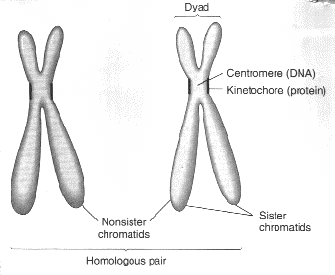Chromosomes
Composition
In eukaryotes, chromosomes consist of a single molecule of DNA associated with:
Structure
- For most of the life of the cell, chromosomes are too elongated and tenuous to be seen under a microscope.
- Before a cell gets ready to divide by mitosis, each chromosome is duplicated (during S phase of the cell cycle).
- As mitosis begins, the duplicated chromosomes condense into short (~ 5 µm) structures which can be stained and easily observed under the light microscope.
- These duplicated chromosomes are called dyads.

- When first seen, the duplicates are held together at the centromere.
- While they are still attached, it is common to call the duplicated chromosomes sister chromatids, but this should not obscure the fact that each is a bona fide chromosome with a full complement of genes.
- The kinetochore is proteinaceous body that forms at the centromere and helps to separate the sister chromatids as mitosis proceeds into anaphase.
- The shorter of the two arms extending from the centromere is called the p arm; the longer is the q arm.
- Staining with the trypsin-giemsa method reveals a series of alternating light and dark bands called G bands.
- G bands are numbered and provide "addresses" for the assignment of gene loci.
Karyotypes
- Dyads occur in homologous pairs, one member of each pair having been acquired from one of the two parents of the individual whose cells are being examined.
- All species have a characteristic number of homologous pairs of chromosomes in their cells called the diploid (or 2n) number.
Diploid numbers of some commonly studied organisms (as well as a few extreme examples)
| Homo sapiens (human) | 46
|
| Mus musculus (house mouse) | 40 |
| Zea mays(corn or maize) | 20 |
| Drosophila melanogaster (fruit fly) | 8 |
| Xenopus laevis (South African clawed frog) | 36 |
| Caenorhabditis elegans (microscopic roundworm) | 12 |
| Equisetum arvense (field horsetail, a plant) | 216 |
| Saccharomyces cerevisiae (budding yeast) | 32 |
| Canis familiaris (domestic dog) | 78 |
| Arabidopsis thaliana (plant in the mustard family) | 10 |
| Myrmecia pilosula (an ant) | 2 |
| Parascaris equorum var. univalens (parasitic roundworm) | 2 |
| Cambarus clarkii (a crayfish) | 200 |
The complete set of chromosomes in the cells of an organism is its karyotype.
The karyotype of the human female contains 23 pairs of homologous chromosomes:
- 22 pairs of autosomes
- 1 pair of X chromosomes
The karyotype of the human male contains:
- the same 22 pairs of autosomes
- one X chromosome
- one Y chromosome
(A gene on the Y chromosome designated SRY is the master switch for making a male.)
The X and Y chromosomes are called the sex chromosomes.)

Above is a human karyotype (of which sex?). It differs from a normal human karyotype in having an extra #21 dyad. As a result, this individual suffered from a developmental disorder called Down Syndrome. The inheritance of an extra chromosome, is called trisomy, in this case trisomy 21. It is an example of aneuploidy

Some Visual Evidence
Location of the gene for muscle glycogen phosphorylase on human chromosome 11
This image (courtesy of David C. Ward) provides dramatic evidence of the truth of the story of chromosomes. A piece of single-stranded DNA was prepared that was complementary to the DNA of the human gene encoding the enzyme muscle glycogen phosphorylase. A fluorescent molecule was attached to this DNA. The dyads in a human cell were treated to denature their DNA; that is, to make the DNA single-stranded. When this preparation was treated with the fluorescent DNA, the complementary sequences found and bound each other. This produced a fluorescent spot close to the centromere of each sister chromatid of two homologous dyads (of chromosome 11, upper right). This analytical procedure, which here revealed the gene locus for the muscle glycogen phosphorylase gene, is called fluorescence in situ hybridization or FISH.
DNA Content
The molecule of DNA in a single human chromosome ranges in size from 50 x 106 nucleotide pairs in the smallest chromosome (stretched full-length this molecule would extend 1.7 cm) up to 250 x 106nucleotide pairs in the largest (which would extend 8.5 cm).
Stretched end-to-end, the DNA in a single human diploid cell would extend over 2 meters.
24 May 1999


